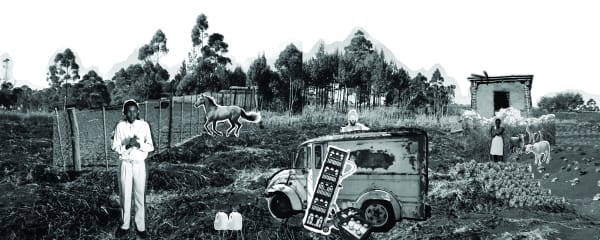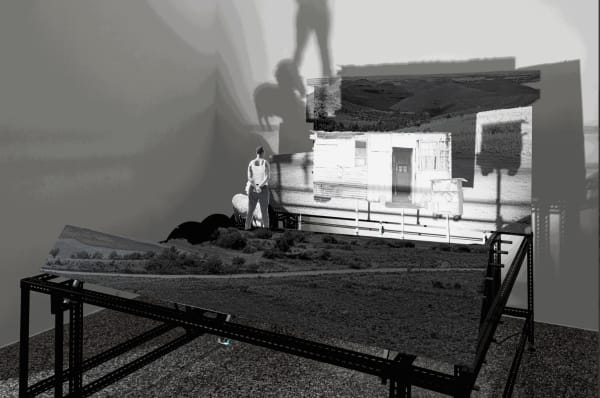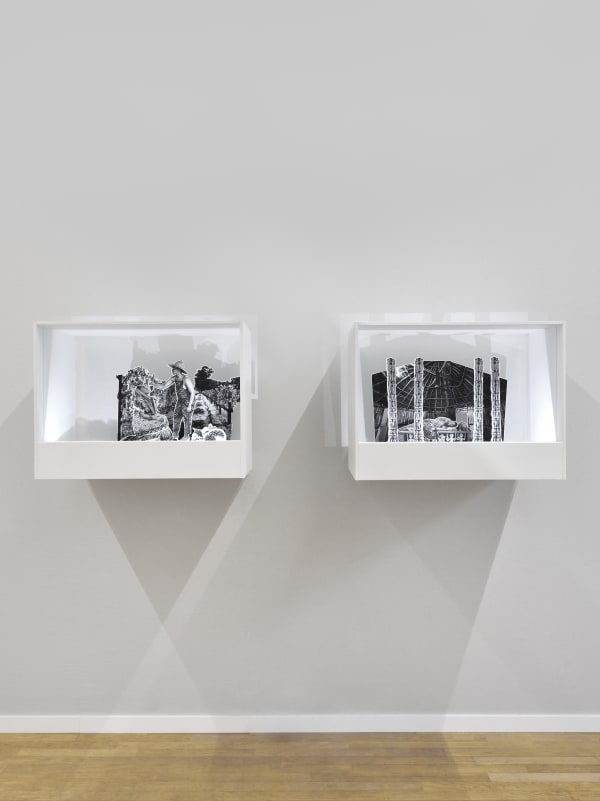-

-
LEBOHANG KGANYE | A WEAVER OF LIGHT
Text by Renée MussaiLight | Dark
In a time of epic metaphorical darkness — as economic, political, social and climatic calamities abound and human rights violations are carried out in the bright nakedness of day — what does it take to labor with light, to tend to light, to practice with light? To make visible, to illuminate, to stimulate sight? How might we prevent the loss, the shadowed, camouflaged concealment of ancestral, personal, familial or tribal memories? How might we direct light towards matrilineal traditions and counter the disabling erasure of women’s agencies, too often obfuscated and obscured?
-
She Illuminates, Recuperates, Amalgamates…
In a world coexistent with this sombre reality, a visual lightworker is transcending the medium of photography, weaving delicate threads of past lives into a conjuring blanket of visibility and soothing recognizability. Working in service of liberation and interpolation, she is interlacing and spinning memories, experiences, anecdotes, familial ontologies and epistemologies into singular assemblages of still and moving image portraitures, amalgamating pictorial frequencies into elaborately constructed scenes of layered animations, recreations, invitations: immersive sculptural installations that simulate and recuperate; intricately knotted, and imaginatively plotted.
-
-
A custodian of polyvocal legacies, Lebohang Kganye is well versed in speculative and performative modes of visual ventriloquism that illuminate her ancestral planes. Light is in her family name — Kganye — embedded deep within its etymology, enshrined in her genealogy, where it resides intimately entwined, affected and fragmented by multiple movements, migrations and transpositions; to deconstruct its shifting meanings, its incantations, and variations is her calling. Forging a photographic language of remediation — trembling, murmuring, illuminating — she reconstructs a narrative where the poetics of historiography, theatricality, indigeneity, and autobiography are amplified and rectified, simultaneously anchored in the symbolic and the real.
-
-
Centering women, in her own lineage and in history at large, through gender-fluid embodiment and reenactments, she punctuates, transmutes, and communes with light as alchemy, as activation, as augmentation, and amplification. Here, light serves as a compass in an ongoing construction, an unfinished — indeed never-finished — conversation on the mechanics of creation and (identity) formation.
-
-
Whether reimagined as life-size cardboard cut-outs in a series of domestic “scenes” that comprise the critically acclaimed, participatory, circular installation Mohlokomedi wa Tora (2018), or transposed onto textile fabric in the more recent Mosebetsi wa Dirithi (2023-24), Kganye tends to her family’s (visual) legacies with illuminating care and cyclical commitment: enlightening, carrying her heritage exuberantly into the present. In Mohlokomedi wa Tora, this light — as method, metaphor and motif — appears at once ruptured, fractured and mended. In Mosebetsi wa Dirithi, commemorative portraits of the artist’s relatives offer a beautiful tapestry for imagining otherwise on solid, light-infused (fore)grounds, and darkly shadowed yet irradiate, silhouetted versos: their upscaled, striking figures evocative of the effervescing, self-fashioning figures from the pages of vernacular photo albums they originate from, now woven into the expansive fabric of a free-flowing present tense, liberated from the confines of the photographic frame.
-
-
Sensitively and expressively rendered, the evolution of Kganye’s family histories — herstories, theirstories, otherstories are pictured in their monumental, immortalized attendances. As individual and collective presences, variably affected by colonial-era land acts and separatist laws during apartheid, by forced migrations and uprooting displacements, they appear to us suspended in an imaginative spatial and temporal choreography where visual and metaphoric interpretations congregate powerfully.
-

-
She Re/En/Act-ivates…
Where are the stories that did not survive or were repressed? Or the faces never seen, the bodies eluding photographic “ capture” who resisted or were overlooked by the recording impulse of a chronicler’s apparatus — pen, camera or otherwise? Who are the characters we haven’t met, the lives never told, the traces not yet found?
Creatively fabulated, and critically fabricated in Kganye’s composite visual vernacular, Keep the Light Faithfully (2022) invites a nuanced reflection on the constructed nature of history, igniting the lost or missing narratives of women light keepers from the nineteenth and twentieth century, remediated through oral testimonies from (male) workers who once operated lighthouses in some of the most isolated parts of South Africa’s coastlines.
-
In a series of diorama works, the image of the lighthouse is subtly evoked in myriad facets: as intimate abode and urgent shelter, as necessary point of reference and orientation that provides navigation, guidance and protection in moments of reduced visibility; as survival; or incarnated as emblematic sign of imperial manifestations on both sea and land, erected to aid the expansion of empires and the movement of trafficked / enslaved people.
-
At the center of the dramaturgy is the artist herself, labouring, signifying, deep inside a loosely scripted narrative of interwoven facts, figures and fictions. Amid these agential acts of inscriptions and memory reworkings, Kganye gathers and embodies other people’s recollections, and through a radical mode of feminist assemblage — cutting, pasting, folding — adapts these fragments into gendered tales of quotidian existence, forged, sculpted and moulded from the fluid storytelling matter of myth(making).
-
-
Here, in this visual world of de/construction and experimentation, the artist — the woman — is always “doing the work”: engaging, like her ascendants (or forbearers), in various forms of oftentimes invisible modes of generative labor and public service. Light and caregiving are intertwined, both disrupting and subverting the racial and gendered ramifications of this work of caring for and repairing with.
-
She Carries / Traces / Enfaces…
A lone figure, visibly burdened by the weight of a heavy sack she carries, treks across the weathered terrain of a panoramic fleet of 22 video panels. Laboriously she traverses and transmutes the emptied topography of a set of drawings, tinged in hues of yellow and almost entirely devoid of people, sequentially inflecting each tableau with her arrival, with the steady movement of her body in continuous motion. Like a wandering artist-alchemist, she transforms the (mono)chromatic landscape of each print… their surfaces irrevocably altered and affected by the sentient force of her physical presence, by her touch, by her passing through a territory that is not her own and that changes, as she crosses, from hand-sketched image to lens-based representation.
-
-
In the immersive film installation A Burden Consumed in Sips (2023), an archival enquiry becomes a kinetic expedition of superimposition in reverse, wherein Kganye disrupts and de-colonizes the work of German painter and photographer Marie Pauline Thorbecke, who made these land-surveying impressions / impositions in 1911 during an ethnographic excursion to Cameroon on behalf of the German Colonial Society.
Buoyed by a soundscape that intensifies scene by scene, gradually erupting into a crescendo of incantations and reverberations, the film’s protagonist wanders stoically through each depiction, inscribing herself into the surveying drawings so violently emptied by their original architect, its indigenous inhabitants erased / removed by the imperial illustrator’s hand. The artist’s interventionist crusade culminates in Kganye repatriating the expedition’s takings — tokens represented in the form of soil and objects, symbolically returned 110 years later: a re/generative, remedial gesture which speaks poignantly to the lingering echoes of imperial extraction and the circulation of “ethnographic collections” housed in European museum depositories, material cultures and artefacts belonging to former African colonies.
-
-
A blackening and a reckoning, Thorbecke’s appropriated ink drawings resounding of a colonial past are poetically subsumed into Kganye’s contemporary compositions to the point of complete annihilation. As Kganye encroaches further into each sketch, both enfaced and animated by her presence, the work poses pertinent questions of ownership, reparation and restitution; of land and objects, people and stories as well as women’s agentivity and the female imperial gaze onto subjugated terrains. Whose burden is it to carry, whose response-ability to remediate, to inscribe and reinscribe?
-
-
Her labour through each carefully composed, reconstituted frame — always still moving, gathering herself and “her” things again and again — brings to mind Ursula K. Le Guin’s seminal essay The Carrier Bag of Fiction wherein she invokes the first cultural device as “a recipient” — a vessel in various forms. “A leaf a gourd a shell a net a bag a sling a sack a bottle a pot a box a container. A holder. A recipient,” she writes, “full of beginnings without ends, of initiations, of losses, of transformations and translations.” How might we continue to walk resiliently, and intentionally, with our carrier bags weighty with gathered “things” and lived experiences, personal, political and otherwise? What urgent, critical questions — or answers — might they hold? What untold stories — burdens — do we keep carrying with(in) us? To whom do they belong? What old stories must we preserve, release, and what new ones must we birth?
-
Dark | Light
As performer and receiver, enactor and translator, Kganye herself is always the vessel, the recipient, the container, directing and dispensing acts of quiet resistance and insistence. Reflecting on the four bodies of work assembled in The Work of Shadows at La Patinoire Royale Bach— with all their potent pictorial, haptic, sonic and affective image frequencies — we can palpably feel, sense, see how Lebohang Kganye, (light)keeper and (light)carrier of memories, is a gatherer of both re/fractions and irradiations / illuminations — a decolonial, feminist weaver of light, reminding us that, even in the darkest of times “still there are seeds to be gathered, and room in the bag of stars.”
Text | © Renée Mussai
Curator | Julien Frydman
Assistant Curator | Allyn Aglaïa
-

-
Lebohang Kganye (b. 1990, South Africa) works with expanded photography, video and mixed media to create deeply researched works that layer historiography, theatricality, autobiography and poetics in often sculptural installations. The artist’s name is etymologically linked to the Sotho word for light “kganya” and bringing light and life to layered postcolonial histories is an animating thread in her practice.
Kganye is featured in MoMA New Photography 2025. She is the recipient of the Deutsche Börse Foundation Prize, 2024 for her exhibition Haufi Nyana? I’ve Come to Take you Home, which took place at Foam, Amsterdam (2023). Other notable recent awards include the Foam Paul Huf Award, 2022, Grand Prix Images Vevey, 2021/22; and Camera Austria Award, 2019.
The artist has recently exhibited at TATE, The Barnes Foundation, the Art Institute of Chicago, Yale University Art Gallery, and others. In 2022, Kganye was one of three artists exhibited in Into the Light, the South African Pavilion at the 59th Venice Biennale.
Kganye’s work is held in public collections including the Smithsonian Institution, the Art Institute of Chicago, Getty Museum, Museum of Fine Arts, Houston, Musée d’Art Moderne de Paris, Victoria and Albert Museum, Verbund Collection, Walther Collection, and Carnegie Art Museum, among others.
-
-

LEBOHANG KGANYE | DEUTSCHE BÖRSE PRIZE
WINNER 16 May 2024Lebohang Kganye won the prestigious Deutsche Börse Photography Foundation Prize for her exhibition Haufi nyana? I’ve come to take you home at Foam, Amsterdam in 2023. The prize was accompanied... -

LEBOHANG KGANYE | MOMA
GROUP EXHIBITION 17 January 2026Lebohang Kganye is exhibiting in New Photography 2025: Lines of Belonging at MOMA in New York, open from September 14, 2025, through January 17, 2026. Since it was launched in... -

LEBOHANG KGANYE | TATE
GROUP EXHIBITION 6 July 2023 - 14 January 2024Lebohang Kganye participated in the group exhibition A World in Common at Tate Modern, curated by Osei Bonsu. Bringing together a group of artists from different generations, this exhibition will... -

ART BRUSSELS | LEBOHANG KGANYE
ART FAIR 24 - 27 April 2025Booth 6A-10 At Art Brussels, Galerie La Patinoire Royale Bach presents a solo show dedicated to Lebohang Kganye’s series, Mosebetsi wa Dirithi (2023-24). The presentation coincides with the artist’s major... -

LEBOHANG KGANYE | ICP INFINITY AWARD
WINNER 1 April 2025Lebohang Kganye has been honored with the Infinity Award in Contemporary Photography & New Media from the International Center of Photography in New York. The International Center of Photography celebrates... -

LEBOHANG KGANYE | VOGUE
PRESS 6 November 2024In Vogue France, Lolita Mang profiles Lebohang Kganye ahead of her presentation with the gallery at Paris Photo 2024. It's hard to place Lebohang Kganye on the spectrum of contemporary...
-
LEBOHANG KGANYE | THE WORK OF SHADOWS
Current viewing_room









